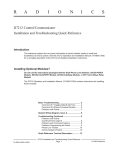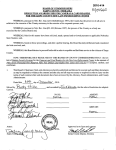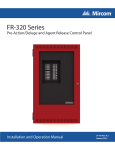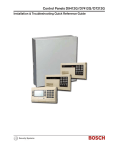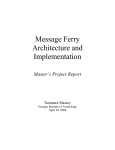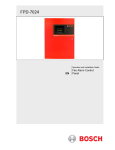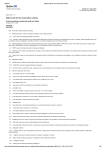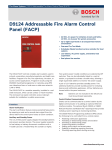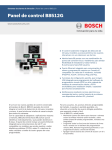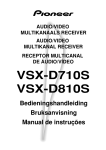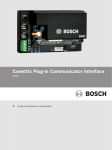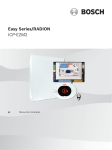Download OUSD Intrusion Alarm System Standards
Transcript
INTRUSION ALARM SYSTEM STANDARD PART 1 - GENERAL 1.01 General and Special Conditions A. This intrusion alarm standard is intended to be used by the architect/intrusion alarm designer of record for the development of detailed intrusion alarm drawings, product data sheets and specifications. This standard should also be followed by the installing contractor, as applicable during the submittal, construction, testing, closeout and warranty phases of the project. The architect/designer’s drawings shall be the only drawings developed and used for the intrusion system installation through the entire duration of the project. Architects shall utilize an Intrusion Consultant, approved by the district, to produce intrusion alarm system construction documents. No Contractor drawings shall be developed. It is recommended that the architect/designer work closely with the Bosch certified vendor to develop detailed drawings for the project. Prior to initial design of the intrusion alarm system by the architect/ intrusion designer, a pre-design meeting shall be scheduled with the OUSD project team. The project team may consist of OUSD’s architect, OUSD’s intrusion alarm consultant; Bosch certified vendor, OUSD’s Building and Grounds (B&G) Alarm Staff, and OUSD’s project manager. It is also recommended that representatives from Bosch be involved in the initial design. B. A mandatory job walk with the architect/intrusion designer and the OUSD project team shall be required prior to the start of the design to review the existing intrusion system and determine the replacement or upgrade of the existing system. It is also recommended but not mandated that the OUSD Bosch vendor attend the job walk to confer on existing devices and equipment to be reused for compatibility. C. As part of the design, consideration shall be made to upgrade or expand the school’s existing intrusion system for conformity. D. On all school repaving projects of playgrounds, drive ways, etc.; after placement of rock, and prior to paving activity the intrusion alarm control unit status shall be verified with OUSD’s Alarm Center District representative before the paving starts. If there is evidence of a problem (underground conduit and wire damaged during the demolition of the existing pavement), corrections shall be made and verified prior to starting the paving activity. Existing structures without fire/intrusion alarm protection connected to the main building fire/intrusion alarm system shall have 2-inch underground conduit installed as part of the repaving project. This is to be coordinated with the OUSD representative. E. Prior to the final design set being submitted to DSA, OUSD requires review of final design documents by the OUSD’s project team. Any comments generated by the OUSD project team shall be addressed by the architect/designer and if requested, the drawings shall be resubmitted to OUSD project team for back check, prior to submitting to DSA. Any comments made by DSA shall be reviewed by OUSD’s project team prior to back-check to DSA. F. Vendors shall be Bosch Certified with a Bosch Certificate of Training issued by Bosch, licensed by the Board of Consumer Affairs and must meet the District’s pre-qualification requirements in the same manner as Electrical Contractors working with the OUSD INTRUSION ALARM SYSTEM STANDARD DECEMBER 9, 2013 PAGE 1 OF 87 representative. Proof of Bosch certification shall be provided to the District Project Manager and forwarded to the OUSD Alarm Department. G. A Bosch-certified technician with a Bosch Certificate of Training issued by Bosch shall supervise the installation acceptable to the OUSD. H. Any Contractor responsible for programming the Bosch panels must have Bosch’s most current RPS program and must be certified on the new software and panel. I. Any company hired by the General Contractor to program the District’s Bosch systems must attend required project meetings and have all required equipment to properly program and test the system with the First Alarm and OUSD Alarm Center Receiver. OUSD does not loan or provide parts needed on a project for any reason. J. When working or expanding on an existing intrusion system, prior to start of work, the Contractor shall contact the B&G Alarm Center through the Project Manager to verify the current status and state of the existing system before start of work. B&G Alarm Center shall send an email to the Project Manager with information on the status of the system for project records. The Project Manager shall provide this information to the Contractor who shall not be held responsible for any repairs that are required prior to start of work. The repairs shall be corrected by OUSD. If there are problems found during or after the start of work, and the Contractor has not contacted B&G Alarm Center prior to start of work, the Contractor shall be responsible for all repairs needed, including time for OUSD’s B&G personnel to repair the problem. K. Any existing intrusion panels shall not be accessed by the Contractor until it is identified and confirmed by B&G that it is an OUSD owned panel. L. When a Radionics 8112 Panel is being replaced with a Bosch D9412GV4, Version 1, OUSD requires all zones connected to the new dialer be tested to both Central Station and OUSD Alarm Receiver when the replacement has been completed. All existing devices that are being transferred shall be tested to both receivers. M. Project Managers shall provide to the Alarm Center a user list for Intrusion Codes prior to going on line. N. Construction trailers on site requiring alarm monitoring equipment or cameras connected to a Central Station must have their own private Alarm Permit registered with the Oakland Police Department and under their own name. The use of Oakland Unified School District as the registered name is prohibited. O. 1. The Contractor shall provide the OUSD Project Manager with the Alarm Permit Number, Alarm Company name and number and Central Station phone numbers. 2. Any false alarm fines billed to Oakland Unified School District caused by the alarm equipment installed while on site are to be paid immediately by the Contractor. False Alarm Prevention Program information is provided in Appendix B for the contractors to use as reference for training to minimize false alarms. INTRUSION ALARM SYSTEM STANDARD DECEMBER 9, 2013 PAGE 2 OF 87 1.02 Submittals A. B. C. General: 1. The OUSD project team shall review the design drawings for conformance with this Standard. If the design is found not to conform to the requirements of this standard; the architect/intrusion designer shall be required to resubmit with modifications. 2. All equipment shall be installed in accordance with the manufacturer’s recommendations and the UL listing limitations. The architect/intrusion alarm designer shall provide evidence with the submittal of listings of all proposed equipment and combinations of equipment. 3. The Bosch vendor shall be consulted to confirm all model numbers of proposed equipment are still valid. Equipment List/Product Data: 1. Prior to DSA submittal, the architect/engineer shall submit a minimum of two (2) hard copies to the OUSD project team of a detailed equipment list, identifying types, models, and quantities of all materials, devices, and equipment proposed. This submittal shall include manufacturer’s data sheets showing the types and models of all equipment, devices, material, and wire proposed. Evidence of UL listings shall be submitted with the data sheets. 2. Submit full sets of product submittals bound in protective binders. A Bill of Materials shall be provided listing the part number and quantity of all components and devices. All data sheets shall be original manufacturer’s literature or shall be clearly legible if copies are provided. When a manufacturer’s data sheet shows more than one product(s), the proposed product shall be clearly indicated by arrows or other suitable means. Construction Documents: 1. Prior to DSA submittal, the architect/engineer shall submit a minimum of two (2) hard copies of the construction documents to the OUSD Project Manager to be reviewed by the OUSD project team for approval. Consultant’s prepared documents shall be adequate for construction without the need for contractor shop drawings. 2. The construction documents shall include, at a minimum, the following information: a. A legend sheet detailing equipment model numbers, descriptions, and device quantities. b. Sequence of Operation for each type of device on the intrusion alarm system. c. School Site Plan – To include: INTRUSION ALARM SYSTEM STANDARD DECEMBER 9, 2013 PAGE 3 OF 87 D. 1.03 1) All structures on site. 2) Each system’s connection(s) and show the interconnection(s) of structures on the site (clearly labeled). 3) Location of the control unit and all power supplies, and arming/disarming stations (keypads). d. A list of all point assignments, point text and associated point index description. Provide device labels as described in Section 3.04.A. e. Building floor plans drawn to scale, showing device locations; complete wiring and schematic diagrams, including quantity, size and type of conductors and conduit for both existing and new, wire color codes, and field terminations; control panel layouts, including all modules, circuit terminals and interconnections,; complete riser diagrams indicating wiring sequence for all devices and control equipment, including all required wiring between the control unit. Drawings shall show proposed layout and anchorage of equipment and appurtenances and equipment relationship to other parts of the work, including clearances for maintenance and operation. Prepare construction documents at a minimum scale of 1/8 inch equals 1 foot for plans. Submittals must be complete. Incomplete submittals may be rejected at the discretion of the architect or OUSD’s intrusion designer. 1. Submit dimensioned elevation details of control panel and power supplies. The Contractor is responsible for the actual location of the control panel and power supply in the designated room. Complete installation shop drawings, including system wiring diagrams, floor plans, and point-to-point wiring diagrams showing all conductors and terminations for all systems. Shop drawings are to be in CAD. Typical or partial diagram or point-to-points shall not be accepted. 2. Manufacturer’s names, model numbers, and catalog references for all equipment supplied. 3. A complete listing of all system input and output points, and a sequence of operations for all functions of each system. 4. A complete Bill of Materials. 5. Battery calculations for all panels and remote power supplies. 6. Service information, including the address and telephone number of the nearest service representative. Definitions A. Approved: INTRUSION ALARM SYSTEM STANDARD DECEMBER 9, 2013 Unless otherwise stated, materials, equipment or submittals approved by the Owner, Owner's Representative or IOR. PAGE 4 OF 87 B. Concealed: Where used in connection with installation of piping or conduit and accessories, shall mean "hidden from sight" as in shafts, furred spaces, soffits or above suspended ceilings. C. Contractor: The Company awarded the prime contract for this work and any of its subcontractors, vendors, suppliers or fabricators. D. Construction Documents: Written, graphic, and pictorial documents prepared or assembled for describing the design, location, and physical characteristics of the elements of a project necessary for obtaining a building permit. E. DACT: Digital Alarm Communicator Transmitter. F. DSA: Division of the State Architect. G. IACP: Intrusion Alarm Control Panel H. IOR: Inspector of Record. I. Listed: Materials or equipment included in a list published by a nationally recognized laboratory that maintains periodic inspection of production of listed equipment and material, and whose listing states either that the equipment or materials meets nationally recognized standards or has been tested and found suitable for use in a specified manner. J. Remove: Remove surface. K. UL: Underwriters' Laboratories, Inc. L. UL Listed: Materials or equipment listed by Underwriters' Laboratories and included in the most recent edition of the UL Fire Protection Equipment Directory. material and equipment and restore PART 2 - PRODUCTS 2.01 Intrusion Alarm System Configuration A. Each and all items of the intrusion alarm system shall be listed as a single intrusion alarm system manufacturer. B. The OUSD Standard for the intrusion alarm equipment is as follows: INTRUSION ALARM SYSTEM STANDARD DECEMBER 9, 2013 PAGE 5 OF 87 2.02 2.03 1. If a new intrusion alarm control system(s) is required, it shall be a Bosch D9412GV4, Version 1 (Version 2 is not allowed). If Version 2 is delivered and/or installed at the site, the Contractor shall be responsible for any cost incurred to replace the panel with Version 1. All Bosch D9412GV4 shall be supplied with a ROM key. 2. Manufacturer’s catalog and system numbers of equipment listed in this standard indicate type, quality, and functions of the equipment required, and represent the minimum acceptable standards. Provide all compatible parts for the submitted system. C. OUSD does not permit or approve of Glass Break Detectors or Octo-popits at any time. D. Where any fire and intrusion alarm systems are being installed at a school site where more than 120 intrusion points are required to protect the site, the 3 Fire Points; FIRE TROUBLE and SUPERVISORY, shall be wired to the D9412GV4’s on-board points 1-8 and Expanders 1 and 2 shall be used for intrusion coverage. Where there are more than 230 points necessary, the fire alarm system shall remain as a stand-alone GV4 with a separate GV4 for intrusion. This shall be determined during plan design and discussed on an individual basis at the pre-design meeting. Manufacturers A. Acceptable manufacturers for this project shall be Bosch. This is a proprietary item to match existing OUSD intrusion alarm standard equipment requirements. No equal shall be accepted. B. Products shall be of the latest design; obsolete or discontinued products shall not be acceptable. All equipment supplied shall be UL listed for the required function. Intrusion Alarm Control Equipment A. The intrusion alarm control panel (IACP) shall be located in the electrical or janitor’s room. Exact location shall be determined at the pre-design meeting and/or as determined by actual or existing conditions B. The control panel shall provide power, annunciation, supervision and control for the motion detectors, contacts, and sounders. The Bosch model is a proprietary item. No equal shall be accepted. The panel shall be modular in construction and contain all modules necessary to operate according to this standard. C. Provide and install Bosch D8108A attack resistant enclosure, D101 lock and key set, D110 tamper switch, D928 dual phone line module, two D161 dual modular telephone cords, two RJ31X phone jacks, two D8125 POPEX expander modules, one D8129 Octorelay module, one DX4020 Network Interface Module, D137 mounting brackets, D1640 transformer, D8004 transformer enclosure, and D122 dual battery harness. D. Provide all necessary internal mounting brackets, hardware, and telephone or data patch cables. INTRUSION ALARM SYSTEM STANDARD DECEMBER 9, 2013 PAGE 6 OF 87 2.04 E. Battery backup for 4 hours of standby shall be provided to power the intrusion alarm systems in the event of AC power failure. Provide a minimum of two D126 12-volt 8-amphour gel-cell batteries. F. AC & Battery power supplies monitored for “Trouble” shall have a new Point Index programmed for the trouble point. G. There is no Common Ground for power supplies (power supplies have a common negative). All shields must be clear of any grounds, be continuous and grounded only at the IACP. H. Provide point identification for all initiating devices. I. The LAN line, CAT 6 cable, shall be installed between the MPOE and the IACP prior to scheduling the final acceptance test. J. The control equipment and/or remote power supplies shall operate from a three-wire 120 VAC supply fed from a single dedicated circuit breaker. The circuit breaker shall be clearly labeled Intrusion Alarm System and shall be fitted with a clip to prevent it from being turned off. Where there is an emergency 120 VAC systems available, the intrusion alarm system and intrusion alarm auxiliary equipment shall be on the emergency panels. The location of the circuit disconnecting means shall be permanently identified at the panel. Remote Power Supplies A. 2.05 Remote Power Supplies 1. Remote power supplies shall be Altronix model AL400ULPD4, 12VDC, 4 Amp, or approved equal. Provide minimum 12-volt, 7-amp-hour gel-cell batteries. Battery backup for 4 hours of standby shall be provided to power the intrusion alarm systems in the event of AC power failure. 2. Monitor remote power supplies for AC power failure, low battery, and battery presence with individual POPITs. Monitor power supply enclosure doors with tamper switch and POPIT. Both battery and AC power loss are to be monitored by separate POPITs and alarm points. 3. Provide and install 120-volt AC power for power supplies. 4. Remote power supplies shall power motion detectors. 5. Remote power supply locations shall be located in the electrical room, unless project dictated. However, mounting heights shall be between 12 inches minimum from the ceiling and 48 inches above the finished floor. Intrusion Alarm Devices A. Keypad 1. The keypad shall be Bosch D1255. INTRUSION ALARM SYSTEM STANDARD DECEMBER 9, 2013 PAGE 7 OF 87 E. 2. Keypads shall not be located in the general public areas and in non-adult supervised locations. 3. OUSD Alarm Center shall be provided with keypad locations at the site in writing. 4. No keypads shall to be installed in a common area such as public hallways where access can be made by students or unauthorized persons. 5. Keypads shall be located in a room accessible from the exterior entry points for example: Data Rooms, Offices, and Custodial Closets. 6. All keypad locations shall be reviewed and accepted in writing by OUSD prior to installation. 7. There shall be a keypad mounted to the front panel door of the D9412GV4 panel enclosure. POPITs 1. F. POPITs shall be Bosch D9127U. Door Contacts 1. Door contacts shall not be used unless there are roof hatches or boiler rooms where motion detectors are not suitable. 2. Roof hatch door contacts shall be GE Sentrol 2204A-L single pole, double throw, or approved equal. Provide proper mounting bracket for job condition (GE Sentrol 19122-L, 19102-L, 1914-M, 1914-N, or approved equal). 3. Flush door contacts shall be GE Sentrol 1076C single pole, double throw with pigtail leads or approved equal. 4. Surface door contacts shall be GE 1084TW single pole double throw with screw terminals and cover, or approved equal. 5. Door and roof hatch contacts shall be closed loop type. Contact shall open when magnet is removed. 6. Each door shall provide for point identification. Provide and install a POPIT for each exterior door or roof hatch contact. 7. Exterior door frames shall be drilled for concealed door contacts. Exterior doors shall be drilled for magnets. 8. Any intrusion devices installed in areas that have a potential to cause false alarms that are not obvious during plan review are to be re-located to areas where protection is provided and false alarms resolved at the Contractors expense. 9. Door Contacts are only allowed in Boiler Rooms, or Roof Hatches. INTRUSION ALARM SYSTEM STANDARD DECEMBER 9, 2013 PAGE 8 OF 87 G. Wall-mounted Motion Detectors 1. Wall-mounted Motion Detectors shall be Bosch Professional Series TriTech+ with Anti-Masking Model ISC-PDL1-WA18GB with the appropriate mounting bracket; a Gimbal-mount bracket Bosch B328 for single-gang box and rotation of the detector or low profile plastic wall swivel mount bracket Bosch B335-3 for vertical pivot range of +10° to -20° and a horizontal pivot range of ±25°. 2. Device shall provide for point identification. 3. Use 4” square box with single gang ring for mounting rough-in. 4. Wire guards are to be used in all public areas; multi-purpose room, gymnasium, cafeterias, locker rooms, and corridors. Wire guards shall be similar to STI-9621WEB or STI-9623. 5. Installation shall be as per manufacturer’s specifications and documentation provided with each unit. OUSD Standards supersedes the manufacturer’s installation requirements. 6. Wall-mounted motion detectors shall be installed at 8 feet above finished floor. Motion detectors shall not be installed in locations that shall permit them to be obstructed by furnishings inside the room such as above shelving nor shall they be aimed directly at a window within its sensing range. Motion detectors shall not be located in corners, but shall be two to three feet from corners to help eliminate spiders from making webs on the detectors. 7. Motion detectors shall not be used in boiler rooms or restrooms. 8. Any motion detector in the path of travel to the location of the keypad shall be programmed with a 90-second ingress and egress delay. 9. Motion detectors shall not be installed in the path of heating/ventilation vents or drafty areas where there is a possibility of temperature changes. Refer to the manufacturer’s recommendations for installation information. 10. Motion detectors in Auditoriums/Multi-purpose Rooms shall be installed so that the detectors are capable of monitoring not only the entry door, but a large portion of the Auditorium/Multi-purpose Room open area. 11. The Contractor shall make the necessary sensitivity adjustments in the field to minimize nuisance alarms. The use of default settings is not acceptable. The Intermediate Sensitivity shall not be used unless approved in writing by OUSD. 12. Any Bosch motion detector that offers an optional “Look Down Zone” for greater security coverage is not to be adjusted for any reason. Failure to comply with this policy will require adjustments or replacement of motion detectors at the Contractor’s expense. 13. Where there is a new addition to an existing intrusion system where there is only an “Add On”: INTRUSION ALARM SYSTEM STANDARD DECEMBER 9, 2013 PAGE 9 OF 87 a. b. c. I. OUSD does not require the Bosch Professional Series Tri-Tech+ Detector with Anti-Masking motion detectors. Bosch ZX825 motion detectors are allowed. Spare parts for “Add On” modification projects shall be four (4) ZX835 motion detectors. Sounders 1. System Sensor MHW mini-horn. 2. Sounders shall be controlled via Octo-relays. 3. Interior sounders shall be provided at locations where they can be heard from every door entry point into the building. There shall be at least one interior sounder installed with every alarm system. There shall be at least one interior sounder for every separate building or group of portables. For Portables, the Contractor shall install one MHW mini-horn in each room. 4. Electric Sounders Philmore PS-1 shall be provided as a supplement to the minihorns. The use of these devices shall be determined during the pre-design meeting. 5. These electric sounders shall be mounted on single gang or handy electrical boxes. A wall plate with a single receptacle sized for the appropriate diameter shall be provided to support the electric sounder. PART 3 - EXECUTION 3.01 New Construction A. Prior to installation of the intrusion alarm system, a pre-construction meeting shall be held with the General Contractor, fire alarm sub-contractor and/or the electrical contractor, if different from the fire alarm sub-contractor, IOR, architect/engineer, and the OUSD project team. B. Certification shall be required for all persons who perform work as electricians for contractors licensed as Class C-10 Electrical Contractors under the Contractor’s State License Board Rules and Regulations. C. During installation, the General Contractor shall notify the OUSD Project Manager that the system is ready for inspection by the OUSD project team at the following stages: conduit rough-in completion (before pulling wire), device connection and final acceptance. After each inspection, the OUSD project team shall issue a report on their findings. This report shall be distributed to the General Contractor, IOR, OUSD Project Manager, and OUSD project team. Any deficiencies noted in these reports shall be corrected before calling for the next subsequent inspection. D. The OUSD Project Manager shall complete the Alarm Permit Application form and submit the document to the OUSD Alarm Center for submittal to Oakland Police Department. (Refer to the Appendix for Alarm Permit Application) INTRUSION ALARM SYSTEM STANDARD DECEMBER 9, 2013 PAGE 10 OF 87 3.02 3.03 Modifications A. Prior to working on the modifications of the intrusion alarm system, the Contractor shall verify the existing conditions of the system and identify any deficiencies to the OUSD Project Manager. The existing intrusion alarm system should be free and clear of troubles prior to the contractor starting work. B. If exterior terminal cabinets or pull boxes are to be re-used as part of the modifications, the Contractor shall review the cable connections prior to starting work to ensure the connections are free of any corrosion and the enclosure has not been compromised with moisture. Any deficiencies shall be identified to the OUSD Project Manager. C. All batteries for modifications utilizing existing control units shall be replaced with new batteries as part of the modification. D. Any and all existing equipment no longer being used after the installation of the new equipment shall be turned over to the District. Any equipment, the District elects not to retain shall be discarded by the Contractor. E. Any after- hours emergency B & G service calls resulting from the Contractor’s work shall be back-charged to the Contractor. F. Any security false alarms caused by the Contractor resulting in false alarm fees from Oakland Police Department shall be back-charged to the Contractor. Wiring and Raceway Configurations A. The Contractor shall follow the manufacturers' recommendation for cabling. Wire and cable sizes, number of conductors, shielding, or other data listed in this standard or if shown on Drawings are a guide to the correct product required to achieve a working system and represent minimum acceptable equipment. Contractor is responsible for calculating and then installing proper wire gauge and type for manufacturer acceptable voltage drop/signal loss/distance limitations. The size of the School campus shall determine the wire gauge of the Zonex or POPIT cables for each project. Minimum gauge shall be 18 gauge. Maximum gauge shall be 12 gauge. B. All intrusion alarm cables shall be installed in conduit. No intrusion alarm cables shall be exposed. No intrusion alarm cables shall share a conduit with telephone, data, or intercom cables. C. All cable installed in underground or under slab conduits shall be listed for outdoor use. West Penn Aqua-Seal or equal shall be used for underground raceways. The underground raceway shall be verified in the field for use and access. D. When an underground wet usage rated cable enters into a building, it shall be continued un-spliced until it reaches the first device or panel. E. When new terminal cabinets or pull boxes are used on the exterior of the building, the enclosure shall be listed for weatherproof use, and water resistant wire nuts shall be used for the cable connections. The enclosure shall be properly sealed with weatherproof gaskets to ensure no moisture shall enter into the enclosure and compromise the cable connections. INTRUSION ALARM SYSTEM STANDARD DECEMBER 9, 2013 PAGE 11 OF 87 3.04 F. There shall be no splicing of cables in underground boxes. G. A pull string shall be installed in all underground conduits. H. For each cable installed in a conduit, there shall be an additional cable of identical type (same brand and model number) installed for future system expansion. I. An additional 12 AWG THHN BLACK wire shall be installed from each remote equipment or power supply location directly back to the main panel to provide for a common reference point connection. J. All cables shall be labeled with the associated circuit number in all terminal cabinets, in the control unit, and in all remote power supplies. K. Cables shall be Belden, West Penn, Atlas, or equal. L. No cables shall be terminated at the control unit until all cables have been tested for continuity in the presence of the Bosch technician and are free of any grounds, faults or shorts. Once the integrity of the cables has been verified, the Bosch technician shall terminate all field wiring at the control unit and power supplies. Terminal cabinets shall be terminated by the contractor. Intrusion Device Labeling A. All initiating devices shall be provided with device labels, which shall indicate the device’s point text and point assignment and shall be consistent with the information provided on the shop drawings. These self-adhesive labels shall be machine manufactured with 3/8” high black letters in bold Arial font on white background. B. Existing devices/circuits that are to be reused need to be reviewed for updated addressing in the program and corresponding physical label on the devices. C. The IACP shall be provided with text label to indicate the location of the initiating device in the field. The text label shall indicate the building name, floor, room number, and associated point assignment and text. D. If the school campus serves multiple administrative entities. The intrusion alarm program point labels shall correspond with each administrative entity that exists on the campus. The program point labels shall be prefixed with the letter corresponding to the associated administrative entity. (Example: L=Life Academy High School, U – United for Success Academy, etc.) E. All Health Centers that service the neighborhood shall be programmed as a separate Area. F. All batteries shall be labeled with the date of installation. G. The text label for the classroom numbers shall be coordinated with the Architectural room numbers for the project. All rooms shall be identified by a permanent room number above the door frame that shall designate the room number for the life of the building regardless of how it is identified by school staff during the years H. The construction documents shall provided a list of labels, which indicate the associated text INTRUSION ALARM SYSTEM STANDARD DECEMBER 9, 2013 PAGE 12 OF 87 label for all of the initiating devices for the system 3.05 Field Quality Control A. Special coordination shall be required with the OUSD’s Alarm Center regarding programming requirements prior to any programming of new or existing control panels. The Contractor shall meet with the OUSD's representatives and submit proposed labels for all input and output points in writing for OUSD review and comment prior to any programming. B. The Contractor shall submit to B&G a completely filled out programming sheet in printed format and in electronic format for preliminary review of proposed programming and descriptors. The Contractor shall make any changes to the programming sheet and directed by the written review comments from B&G. (Refer to Appendix for samples of programming sheets). 1. When programming zones to indicated locations of alarms in the “Point Text”, do not program the “Point Number” or abbreviations in the point field text. 2. OUSD requires all intrusion point index programming to use the listed assignments in the Appendix A. 3. Once the installation has passed the FINAL test, the Contractor temporary code, SERVICE codes 123 and 12345 are to be removed from the program and/or the OUSD Alarm Department notified to remove these codes. C. If there are more that one of the same type of location (i.e.: Hall, Stairwell, Office, Storage, Janitor Closet, Rest Room, Counselor, Staff), the descriptor must indicate what area of which building. Programming with duplicate identical descriptor for different locations will be rejected by OUSD and the Contractor will be required to revise programming. If any programming is found to be incorrect by the Alarm Center, the Contractor’s Project Manager will be notified via email. The Contractor shall correct programming before continuing with project. All programming must be approved by the Alarm Center before final testing of the alarm system can be scheduled. D. Programming for doors contacts, time zones, arming stations, motion sensors, tamper switches, etc. shall include text description locating initiating devices in the program with room numbers to be found on permanently mounted placards at room locations. Example: Point # Point 143 E. Label Room B203 Point Index 4 Point Index Description MD-Instant Area 2 The Contractor for any intrusion installation/modifications must receive a temporary alarm code for programming through the OUSD Project Manager before any programming is done. At no time shall the Contractor extract alarm codes from the existing intrusion alarm system. 1. If OUSD Alarm Center personnel verify that the existing codes are compromised at the site, the Contractor shall be liable for OUSD Alarm Center’s programming INTRUSION ALARM SYSTEM STANDARD DECEMBER 9, 2013 PAGE 13 OF 87 cost to correct the codes. An hourly rate of $26.75 with a minimum 2 hours of OUSD’s Alarm Center’s programming time shall be charged to the Contractor. 2. If Master District codes where all intrusion systems use the same Master District code are compromised, all intrusion system codes shall be deleted and reprogrammed by OUSD’s Alarm Center. A minimum of 60 hours at the aforementioned hourly rate will be charged to the Contractor. 3. It is a violation of security standards, as well as OUSD Standards to extract any secure or confidential information through security equipment unless OUSD’s Alarm Center has been contacted and has approved access for a specific reason. 4. Any Contractor that has access to OUSD’s security information shall be licensed by the Board of Consumer Affairs. 5. Should a violation occur, OUSD shall file a report and formal complaint of the Contractor to the Board of Consumer Affairs of the violation in protocol. F. Once the Contractor has programmed the system, they are to notify the OUSD’s Representative at OUSD’s Alarm Center in writing. Should there be any problems with either the installation of hardware and/or devices or programming errors, the Alarm Center shall notify the Project Manager to have the Contractor repair and/or correct all issues. Once complete, the Alarm Center is to be notified, so they can contact the panel and check the status. This shall be repeated until the system is clear of troubles and the Contractor can proceed with his work. Once the programming has been completed by the Contractor and has been accepted by the Alarm Center, then the Alarm Center will call up the panel and upload the program and send the zone information to the Central Station Monitoring Company for programming update on the Central Station Receiver. G. The control panel and the program shall be the property of Oakland Unified School District and not the contractor. As such, no data lock or access codes shall be allowed with this system. Final payment cannot be made and the warranty period cannot begin until any such data lock or access codes (other than factory default codes) are removed. H. Programming software and programming files shall belong to Oakland Unified School District. Turn over programming software and programming files before end of project. Final payment cannot be made and the warranty period cannot begin until programming software and programming files have been received by Oakland Unified School District. I. Any wiring problems or troubleshooting assistance needs to be provided by a Bosch Certified Vendor on a prevailing wage basis obtained by the Contractor. J. OUSD B&G Alarm Center Protocols: 1. OUSD Alarm Center and its technicians scope of work does not include assisting, advising, consulting, troubleshooting or supporting any contractor hired to do intrusion installations. 2. OUSD reserves the right to check the progress and status of all installations at anytime during the project with or without the permission of the superintendant at the site. INTRUSION ALARM SYSTEM STANDARD DECEMBER 9, 2013 PAGE 14 OF 87 3.06 3. Deliver to B&G Alarm Center in written format on Contractor’s letterhead (three copies required – one for B&B, one for Contractor, and one for IOR) the scope of work including the panel type, the Contractor’s project manager’s name and phone number, and panel’s phone numbers. Contractor responsible for ordering phones lines through B&G. Include estimate of expected test date. 4. The Contractor shall provide the Alarm Center’s phone number to all subcontractors who are in needed of having the existing alarm systems placed on test mode. The Alarm Center’s normal business hours phone number is 510535-2736 and after-hours phone number is 510-277-6249. Email address for Alarm Center contact person is [email protected]. 5. The Contractor shall submit a request in writing to the IOR for a list of authorized security code holders. The IOR shall submit this request to OUSD. OUSD shall provide in writing the full names and titles of all persons who are to have authorized security codes. 6. Security cards shall be provided by the Alarm Center for the site Administrator and authorized staff. Security cards shall be picked up from B&G Alarm Department by the OUSD project manager for distribution to the Administrator prior to going on line. Testing A. The OUSD project team shall be notified 72 hours prior to any and all acceptance testing of intrusion alarm systems and OUSD project team shall be scheduled to attend the testing on site or at the OUSD Alarm Department Central Station. B. Prior to the pre-test with the OUSD team, the Contractor shall perform a complete operational and functional test with the Bosch representative at least two weeks prior to scheduling a final acceptance test. Prior to the pre-test the intrusion alarm system shall be in a normal condition. The pre-test shall be for all intrusion alarm equipment and testing records of the pre-test shall be provided to ensure a successful final acceptance test. The scope of work as part of the project shall be 100 percent complete and shall be verified by the general contractor. If this requirement is not met and the test is terminated the cost to reschedule the inspection team shall be the responsibility of the general contractor. As part of the completion of work on the intrusion alarm systems, a full documented test of all the components of the intrusion alarm system shall be performed. A representative from the OUSD project team shall be present for the test on site or at the OUSD Alarm Department Central Station. Any deficiencies reported by the district representatives and/or district consultant shall be corrected and re-tested prior to calling for the final inspection. C. A report certifying that the installation is complete, pre-tested, and fully operational shall be developed and forwarded by the intrusion alarm technician to the OUSD Project Manager. D. The Contractor, OUSD project team, the IOR and an authorized Bosch representative shall be in attendance at the pre-test and final acceptance test to make any necessary adjustments. The test shall include, but not be limited to: 1. Activation of all motion detectors and door contacts. INTRUSION ALARM SYSTEM STANDARD DECEMBER 9, 2013 PAGE 15 OF 87 2. Activation and visual check of every sounder. 3. Aon FPE and/or B & G shall be present at the pre-test. 4. Alarm Department and First Alarm shall participate in all intrusion system pre-tests to ensure signals are being received. B & G Alarm Department shall confirm signals have been received. 5. Once the pre-test is complete, the Alarm Department shall provide the Project Manager a list of any alarm points that were not received at the Bosch Panel. These alarms shall be re-activated and must be re-transmitted to both First Alarm and the OUSD Central Station prior to scheduling the final test. 6. If the pre-test is successful, at the discretion of the IOR, the pre-test may be considered the final acceptance test. E. The Contractor shall pay all overtime fees required by the IOR for witnessing the acceptance test. F. Punch list items should be developed at the pre-test, and completed by the final acceptance test date, providing OUSD with a 100% functional and operating system, with no residual repair issues or requirements. G. The Contractor’s project manager shall be responsible for contacting and coordinating with Buildings and Grounds personnel. K. The Alarm Center shall advise the Contractor and IOR in writing (email acceptable method) once all data has been entered into the alarm system and Central Station. Only after receiving this notification shall the Contractor request a time and date for final testing. L. Final testing shall be performed by the Contractor in the presence of the IOR. B&G may or may not have personnel at final test. M. Provide property watch through the OUSD Custodial Services Department if the system is not operational at the final. If intrusion watch is required, then the Project Manager shall discuss the intrusion watch requirement with B&G to make the necessary arrangement with OUSD personnel. N. Testing shall not be conducted during school or custodial hours or any school functions. The building(s) must be completely unoccupied during any testing. O. After reviewing and approving documentation of final test submitted by the Contractor and after comparing documentation with Alarm Center’s receiver and the Central Station’s receiver, the Alarm Center will notify the Contractor that the alarm system is live (on line) and is ready to be handed over to B&G. P. At the time that a new intrusion alarm panel/dialer is installed and ready to be put online, the Contractor shall place the panel into test mode with the District’s Alarm Center (phone 510-535.2736) and perform a complete walk test to confirm that the First Alarm and the OUSD B&G Alarm Department’s Central Station receives all programmed points INTRUSION ALARM SYSTEM STANDARD DECEMBER 9, 2013 PAGE 16 OF 87 prior to putting the system online with the Central Station. All devices shall be tested and reporting to the Central Station and the District’s Alarm Center. Once confirmation that all points have been received by both First Alarm and the OUSD B&G Alarm Department’s Central Station, B&G will advise First Alarm’s Central Station that the system is officially online. The Contractor shall request from the OUSD Project Manager to obtain from B&G a written memo as to the time and date that the system was officially put online. A copy of this memo shall be submitted to the IOR. 3.07 Q. On all projects where an existing intrusion alarm system is in place and new devices are added to the existing intrusion alarm system, the Contractor must provide a 100% test of all new devices. R. The Contractor shall pay all overtime fees required by the IOR for witnessing the acceptance test. S. When an existing intrusion alarm system is modified or altered, 10 percent of devices that are not directly affected by the change, up to a maximum of 50 devices, shall be tested to assure the IOR and the OUSD project team that the existing devices are functional. If any of the 10 percent devices fail, only the repaired devices need to be re-tested after they are repaired or replaced. The Contractor shall be required to test 10% of the existing devices as part of their scope. T. The Contractor shall provide a count to OUSD Alarm Center for the quantity of new and existing intrusion alarm devices to be tested prior to testing. U. If the intrusion alarm installation or modification is in “phased” stages or if there are substantial corrections and additions to the scope of the project, then the Contractor shall assume responsibility for subsequent testing and retesting of the intrusion alarm system installation. After the last phase of the intrusion alarm system has been completed and tested totally, ten percent of the previously completed phases are to be tested with the final tested phase. V. The Contractor’s project manager shall be responsible for contacting and coordinating with Buildings and Grounds personnel. W. Provide an 8.5 x 11 inch site plan indicating the school name, school buildings (identified) and location of the GV4, power supplies and keypads. This site plan shall be provided to OUSD Alarm Center prior to testing. X. Provide complete Final Test Report of system along with Operation and Maintenance manuals, As-Built Drawings, and Warranty information. This information shall be provided before commencement of training. Training A. Any Bosch Security System installations shall include training of site personnel. The training program for the Owner’s personnel shall include the following: 1. Operations and Maintenance Manuals including 11- by 17-inch as-built drawings. Operations and Maintenance Manuals shall be a binder, containing complete operating instructions, outlining step-by-step procedures required for system start up, operation, and shut down, including the manufacturer's name, model number, INTRUSION ALARM SYSTEM STANDARD DECEMBER 9, 2013 PAGE 17 OF 87 service manual, parts lists, and brief description of all equipment and their basic operation features. Complete maintenance instructions listing routine maintenance procedures, possible breakdowns and repairs, trouble-shooting guide, and as-built drawings of the complete system, including conduit layout, equipment layout, device labels, and simplified wiring and control diagrams of the system. Two Operations and Maintenance Manuals shall be submitted and approved prior to conducting the training course. 3.07 2. Manuals containing listings of all points, event programs, basic programming and instructions, and software troubleshooting information. 3. Two-hour training session for site and operating personnel. The session shall cover proper operating and response procedures, including training on false alarm prevention, system operations and fire keypad operation. 4. Instructions provided by the District regarding other alarm system information such as identification label changes, code requests, service need information, Oakland Police Department’s online test requirements, and the site’s alarm permit number, account number, and current status are to be reviewed with the staff administrators and principals during the training session. Warranty A. The Contractor shall warrant all materials, equipment, and workmanship to be free of defective materials, erroneous or missing programming, and faulty workmanship for one year from written notification of acceptance by Owner. The costs of such warranty shall be part of the project cost. If repairs are necessary during the warranty period, the Contractor shall furnish all parts and labor to restore the system to normal operation at no cost to the Owner. The warranty period starts when the entire project is 100 percent completed and accepted in writing. During the warranty period, the District shall monitor the site and request service as required through the appropriate installer. One month prior to the expiration of the warranty period, the factory-trained service representative shall conduct a 100 percent test of the work performed. Any deficiencies found during that testing shall be corrected under the warranty agreement. B. The warranty shall include all necessary material, travel, labor and parts to replace defective components or materials, and all necessary factory and field software required to perform the specified tasks. C. The Contractor shall commence repair of any “in warranty” defects within 24 hours of notification of such defects. Warranty service shall be performed by a Bosch certified field service technician. D. The Contractor shall provide, upon notification of a problem, a Bosch certified field service technician to correct the problem within 24 hours of notification. The Contractor shall provide loaner equipment if unable to repair faulty equipment within 48 hours of notification. The loaner equipment shall be operational within 48 hours of the original notification of a problem. E. Any component of the intrusion alarm system that becomes defective or non-operational during the one-year warranty period shall be repaired or replaced to the satisfaction of OUSD. If repairs are not made within the one-year warranty period the defective or non- INTRUSION ALARM SYSTEM STANDARD DECEMBER 9, 2013 PAGE 18 OF 87 operational component shall be repaired at the Contractor’s cost and shall not fall out of warranty. 3.08 3.09 Spare Parts A. The following spare parts shall be furnished to OUSD: 1. One (1) spare arming station – D1255 2. Three (3) spare motion detectors 3. One (1) sounder 4. One (1) D8125 Expansion Module 5. Two (2) spare POPITs B. All spare parts shall be new and not previously used. C. Turn over to OUSD project manager during the test of the intrusion system in factory sealed cartons. Security cards shall be picked up from B&G by the OUSD project manager for distribution to the Contractor As-Built Project Records A. B. Before acceptance of work and final completion, the Contractor shall provide project record “as-built” hard copy drawings and in AutoCAD format, reflecting any and all changes and deviations made to the fire alarm system during construction. The drawings shall indicate the following: 1. As-built physical routing of wires to devices, including junction box locations. 2. As-built riser diagram showing the zoning of devices and sounders. 3. As-built panel wiring diagrams of the intrusion control panel(s) and power supplies. 4. Floor plan with final room number showing each intrusion device, notification appliance, keypad and control point with their respective address identification number (i.e., an address of (MD1-24) for Device 24 on Expansion Board 1). 5. All electrical circuit breaker panels and circuit numbers used for the IACP and remote power supplies. 6. The original red-lined drawings that indicate true as-builts that have been updated throughout the duration of construction shall be submitted to the fire alarm vendor for their use in creating “As-Built” drawings. These drawings shall be returned to the Contractor if requested. Retention monies shall be withheld if the original as-built drawings are not provided. 7. The acceptance testing records. Upon completion of the work, three sets of blackline record drawings shall be submitted to OUSD. Additionally a CD with the intrusion alarm system as-builts in AutoCAD version 2007, full-size PDF drawing files, and a scanned copy of the final test forms signed by all parties shall be submitted as part of the close-out package. END OF INTRUSION ALARM SYSTEM STANDARD INTRUSION ALARM SYSTEM STANDARD DECEMBER 9, 2013 PAGE 19 OF 87 APPENDIX A INTRUSION ALARM SYSTEM STANDARD DECEMBER 9, 2013 PAGE 20 OF 87 INTRUSION ALARM SYSTEM STANDARD DECEMBER 9, 2013 PAGE 21 OF 87 INTRUSION ALARM SYSTEM STANDARD DECEMBER 9, 2013 PAGE 22 OF 87 INTRUSION ALARM SYSTEM STANDARD DECEMBER 9, 2013 PAGE 23 OF 87 INTRUSION ALARM SYSTEM STANDARD DECEMBER 9, 2013 PAGE 24 OF 87 INTRUSION ALARM SYSTEM STANDARD DECEMBER 9, 2013 PAGE 25 OF 87 INTRUSION ALARM SYSTEM STANDARD DECEMBER 9, 2013 PAGE 26 OF 87 INTRUSION ALARM SYSTEM STANDARD DECEMBER 9, 2013 PAGE 27 OF 87 INTRUSION ALARM SYSTEM STANDARD DECEMBER 9, 2013 PAGE 28 OF 87 INTRUSION ALARM SYSTEM STANDARD DECEMBER 9, 2013 PAGE 29 OF 87 INTRUSION ALARM SYSTEM STANDARD DECEMBER 9, 2013 PAGE 30 OF 87 INTRUSION ALARM SYSTEM STANDARD DECEMBER 9, 2013 PAGE 31 OF 87 INTRUSION ALARM SYSTEM STANDARD DECEMBER 9, 2013 PAGE 32 OF 87 INTRUSION ALARM SYSTEM STANDARD DECEMBER 9, 2013 PAGE 33 OF 87 INTRUSION ALARM SYSTEM STANDARD DECEMBER 9, 2013 PAGE 34 OF 87 INTRUSION ALARM SYSTEM STANDARD DECEMBER 9, 2013 PAGE 35 OF 87 INTRUSION ALARM SYSTEM STANDARD DECEMBER 9, 2013 PAGE 36 OF 87 INTRUSION ALARM SYSTEM STANDARD DECEMBER 9, 2013 PAGE 37 OF 87 INTRUSION ALARM SYSTEM STANDARD DECEMBER 9, 2013 PAGE 38 OF 87 INTRUSION ALARM SYSTEM STANDARD DECEMBER 9, 2013 PAGE 39 OF 87 INTRUSION ALARM SYSTEM STANDARD DECEMBER 9, 2013 PAGE 40 OF 87 INTRUSION ALARM SYSTEM STANDARD DECEMBER 9, 2013 PAGE 41 OF 87 INTRUSION ALARM SYSTEM STANDARD DECEMBER 9, 2013 PAGE 42 OF 87 INTRUSION ALARM SYSTEM STANDARD DECEMBER 9, 2013 PAGE 43 OF 87 INTRUSION ALARM SYSTEM STANDARD DECEMBER 9, 2013 PAGE 44 OF 87 INTRUSION ALARM SYSTEM STANDARD DECEMBER 9, 2013 PAGE 45 OF 87 INTRUSION ALARM SYSTEM STANDARD DECEMBER 9, 2013 PAGE 46 OF 87 INTRUSION ALARM SYSTEM STANDARD DECEMBER 9, 2013 PAGE 47 OF 87 INTRUSION ALARM SYSTEM STANDARD DECEMBER 9, 2013 PAGE 48 OF 87 INTRUSION ALARM SYSTEM STANDARD DECEMBER 9, 2013 PAGE 49 OF 87 INTRUSION ALARM SYSTEM STANDARD DECEMBER 9, 2013 PAGE 50 OF 87 APPENDIX B INTRUSION ALARM SYSTEM STANDARD DECEMBER 9, 2013 PAGE 51 OF 87 INTRUSION ALARM SYSTEM STANDARD DECEMBER 9, 2013 PAGE 52 OF 87 INTRUSION ALARM SYSTEM STANDARD DECEMBER 9, 2013 PAGE 53 OF 87 INTRUSION ALARM SYSTEM STANDARD DECEMBER 9, 2013 PAGE 54 OF 87 INTRUSION ALARM SYSTEM STANDARD DECEMBER 9, 2013 PAGE 55 OF 87 INTRUSION ALARM SYSTEM STANDARD DECEMBER 9, 2013 PAGE 56 OF 87 INTRUSION ALARM SYSTEM STANDARD DECEMBER 9, 2013 PAGE 57 OF 87 INTRUSION ALARM SYSTEM STANDARD DECEMBER 9, 2013 PAGE 58 OF 87 INTRUSION ALARM SYSTEM STANDARD DECEMBER 9, 2013 PAGE 59 OF 87 INTRUSION ALARM SYSTEM STANDARD DECEMBER 9, 2013 PAGE 60 OF 87 INTRUSION ALARM SYSTEM STANDARD DECEMBER 9, 2013 PAGE 61 OF 87 INTRUSION ALARM SYSTEM STANDARD DECEMBER 9, 2013 PAGE 62 OF 87 INTRUSION ALARM SYSTEM STANDARD DECEMBER 9, 2013 PAGE 63 OF 87 INTRUSION ALARM SYSTEM STANDARD DECEMBER 9, 2013 PAGE 64 OF 87 INTRUSION ALARM SYSTEM STANDARD DECEMBER 9, 2013 PAGE 65 OF 87 INTRUSION ALARM SYSTEM STANDARD DECEMBER 9, 2013 PAGE 66 OF 87 INTRUSION ALARM SYSTEM STANDARD DECEMBER 9, 2013 PAGE 67 OF 87 INTRUSION ALARM SYSTEM STANDARD DECEMBER 9, 2013 PAGE 68 OF 87 INTRUSION ALARM SYSTEM STANDARD DECEMBER 9, 2013 PAGE 69 OF 87 INTRUSION ALARM SYSTEM STANDARD DECEMBER 9, 2013 PAGE 70 OF 87 INTRUSION ALARM SYSTEM STANDARD DECEMBER 9, 2013 PAGE 71 OF 87 INTRUSION ALARM SYSTEM STANDARD DECEMBER 9, 2013 PAGE 72 OF 87 INTRUSION ALARM SYSTEM STANDARD DECEMBER 9, 2013 PAGE 73 OF 87 INTRUSION ALARM SYSTEM STANDARD DECEMBER 9, 2013 PAGE 74 OF 87 INTRUSION ALARM SYSTEM STANDARD DECEMBER 9, 2013 PAGE 75 OF 87 INTRUSION ALARM SYSTEM STANDARD DECEMBER 9, 2013 PAGE 76 OF 87 INTRUSION ALARM SYSTEM STANDARD DECEMBER 9, 2013 PAGE 77 OF 87 INTRUSION ALARM SYSTEM STANDARD DECEMBER 9, 2013 PAGE 78 OF 87 INTRUSION ALARM SYSTEM STANDARD DECEMBER 9, 2013 PAGE 79 OF 87 INTRUSION ALARM SYSTEM STANDARD DECEMBER 9, 2013 PAGE 80 OF 87 INTRUSION ALARM SYSTEM STANDARD DECEMBER 9, 2013 PAGE 81 OF 87 INTRUSION ALARM SYSTEM STANDARD DECEMBER 9, 2013 PAGE 82 OF 87 INTRUSION ALARM SYSTEM STANDARD DECEMBER 9, 2013 PAGE 83 OF 87 INTRUSION ALARM SYSTEM STANDARD DECEMBER 9, 2013 PAGE 84 OF 87 INTRUSION ALARM SYSTEM STANDARD DECEMBER 9, 2013 PAGE 85 OF 87 INTRUSION ALARM SYSTEM STANDARD DECEMBER 9, 2013 PAGE 86 OF 87 INTRUSION ALARM SYSTEM STANDARD DECEMBER 9, 2013 PAGE 87 OF 87























































































